

Austin - A Frame Stack Sampler for CPython
Austin - A Frame Stack Sampler for CPython
Synopsis
Austin is a Python frame stack sampler for CPython written in pure C. Samples are collected by reading the CPython interpreter virtual memory space to retrieve information about the currently running threads along with the stack of the frames that are being executed. Hence, one can use Austin to easily make powerful statistical profilers that have minimal impact on the target application and that don’t require any instrumentation.
The key features of Austin are:
- Zero instrumentation;
- Minimal impact;
- Fast and lightweight;
- Time and memory profiling;
- Built-in support for multi-process applications (e.g.
mod_wsgi).
The simplest way to turn Austin into a full-fledged profiler is to use together with the VS Code extension or combine it with FlameGraph or Speedscope. However, Austin’s simple output format can be piped into any other external or custom tool for further processing. Look, for instance, at the following Python TUI
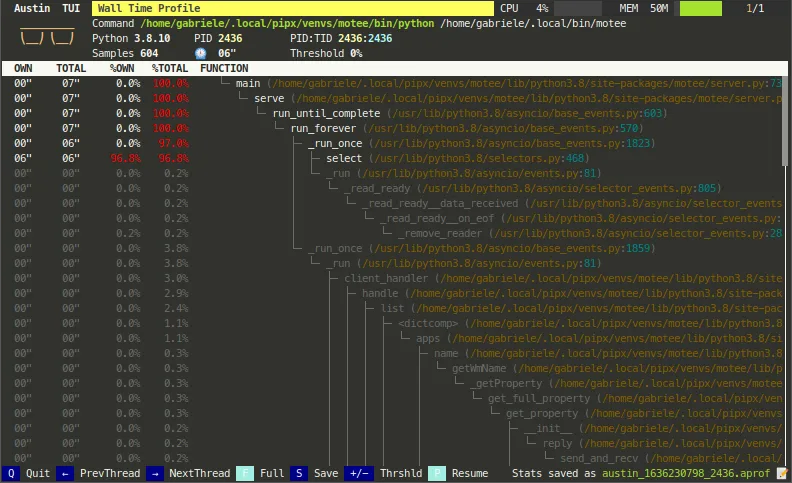
Check out A Survey of Open-Source Python Profilers by Peter Norton for a general overview of Austin.
Keep reading for more tool ideas and examples!
💜 Austin is a free and open-source project. A lot of effort goes into its development to ensure the best performance and that it stays up-to-date with the latest Python releases. If you find it useful, consider sponsoring this project. 🙏
Installation
Austin is available to install from PyPI and from the major software repositories of the most popular platforms. Check out the latest release page for pre-compiled binaries and installation packages.
On all supported platforms and architectures, Austin can be installed from PyPI with pip or pipx via the commands
pip install austin-distor
pipx install austin-distOn Linux, it can be installed using autotools or as a snap from the Snap Store. The latter will automatically perform the steps of the autotools method with a single command. On distributions derived from Debian, Austin can be installed from the official repositories with apt. Anaconda users can install Austin from Conda Forge.
On Windows, Austin can be easily installed from the command line using either Chocolatey or Scoop. Alternatively, you can download the installer from the latest release page.
On macOS, Austin can be easily installed from the command line using Homebrew. Anaconda users can install Austin from Conda Forge.
For any other platforms, compiling Austin from sources is as easy as cloning the repository and running the C compiler. The Releases page has many pre-compiled binaries that are ready to be uncompressed and used.
With autotools
Installing Austin using autotools amounts to the usual ./configure, make and make install finger gymnastic. The only dependency is the standard C library. Before proceeding with the steps below, make sure that the autotools are installed on your system. Refer to your distro’s documentation for details on how to do so.
git clone --depth=1 https://github.com/P403n1x87/austin.git && cd austinautoreconf --install./configuremakemake installNOTE Some Linux distributions, like Manjaro, might require the execution of
automake --add-missingbefore./configure.
Alternatively, sources can be compiled with just a C compiler (see below).
From the Snap Store
Austin can be installed on many major Linux distributions from the Snap Store with the following command
sudo snap install austin --classicOn Debian and Derivatives
On March 30 2019 Austin was accepted into the official Debian repositories and can therefore be installed with the apt utility.
sudo apt update -y && sudo apt install austin -yOn macOS
Austin can be installed on macOS using Homebrew:
brew install austinFrom Chocolatey
To install Austin from Chocolatey, run the following command from the command line or from PowerShell
choco install austinTo upgrade run the following command from the command line or from PowerShell:
choco upgrade austinFrom Scoop
To install Austin using Scoop, run the following command from the command line or PowerShell
scoop install austinTo upgrade run the following command from the command line or PowerShell:
scoop updateFrom Conda Forge
Anaconda users on Linux and macOS can install Austin from Conda Forge with the command
conda install -c conda-forge austinFrom Sources without autotools
To install Austin from sources using the GNU C compiler, without autotools, clone the repository with
git clone --depth=1 https://github.com/P403n1x87/austin.gitOn Linux, one can then use the command
gcc -O3 -Os -Wall -pthread src/*.c -o src/austinwhereas on macOS it is enough to run
gcc -O3 -Os -Wall src/*.c -o src/austinOn Windows, the -lpsapi -lntdll switches are needed
gcc -O3 -Os -Wall -lpsapi -lntdll src/*.c -o src/austinAdd -DDEBUG if you need a more verbose log. This is useful if you encounter a bug with Austin and you want to report it here.
Usage
Usage: austin [OPTION...] command [ARG...]Austin is a frame stack sampler for CPython that is used to extract profilingdata out of a running Python process (and all its children, if required) thatrequires no instrumentation and has practically no impact on the tracee.
-b, --binary Emit data in the MOJO binary format. See https://github.com/P403n1x87/austin/wiki/The-MOJO-file-format for more details. -C, --children Attach to child processes. -f, --full Produce the full set of metrics (time +mem -mem). -g, --gc Sample the garbage collector state. -h, --heap=n_mb Maximum heap size to allocate to increase sampling accuracy, in MB (default is 0). -i, --interval=n_us Sampling interval in microseconds (default is 100). Accepted units: s, ms, us. -m, --memory Profile memory usage. -o, --output=FILE Specify an output file for the collected samples. -p, --pid=PID Attach to the process with the given PID. -P, --pipe Pipe mode. Use when piping Austin output. -s, --sleepless Suppress idle samples to estimate CPU time. -t, --timeout=n_ms Start up wait time in milliseconds (default is 100). Accepted units: s, ms. -w, --where=PID Dump the stacks of all the threads within the process with the given PID. -x, --exposure=n_sec Sample for n_sec seconds only. -?, --help Give this help list --usage Give a short usage message -V, --version Print program version
Mandatory or optional arguments to long options are also mandatory or optionalfor any corresponding short options.
Report bugs to <https://github.com/P403n1x87/austin/issues>.The output is a sequence of frame stack samples, one on each line. The format is the collapsed one that is recognised by FlameGraph so that it can be piped straight to flamegraph.pl for a quick visualisation, or redirected to a file for some further processing.
By default, each line has the following structure:
P<pid>;T<iid>:<tid>[;[frame]]* [metric]*where the structure of [frame] and the number and type of metrics on each line depend on the mode. The <pid>, <iid> and <tid> component represent the process ID, the sub-interpreter ID, and the thread ID respectively.
Why Austin
When there already are similar tools out there, it’s normal to wonder why one should be interested in yet another one. So here is a list of features that currently distinguish Austin.
- Written in pure C Austin is written in pure C code. There are no dependencies on third-party libraries except for the standard C library and the API provided by the Operating System.
- Just a sampler Austin is just a frame stack sampler. It looks into a running Python application at regular intervals of time and dumps whatever frame stack it finds. The samples can then be analysed at a later time so that Austin can sample at rates higher than other non-C alternatives that perform some aggregations at run-time.
- Simple output, powerful tools Austin uses the collapsed stack format of FlameGraph that is easy to parse. You can then go and build your own tool to analyse Austin’s output. You could even make a player that replays the application execution in slow motion, so that you can see what has happened in temporal order.
- Small size Austin compiles to a single binary executable of just a bunch of KB.
- Easy to maintain Occasionally, the Python C API changes and Austin will need to be adjusted to new releases. However, given that Austin, like CPython, is written in C, implementing the new changes is rather straight-forward.
Examples
The following flame graph has been obtained with the command
austin -i 1ms ./test.py | sed '/^#/d' | ./flamegraph.pl --countname=μs > test.svgwhere the sample test.py script has the execute permission and the following content
#!/usr/bin/env python3
import dis
for i in range(1000): dis.dis(dis.dis)To profile Apache2 WSGI application, one can attach Austin to the web server with
austin -Cp `pgrep apache2 | head -n 1`Any child processes will be automatically detected as they are created and Austin will sample them too.
IDE Extensions
It is easy to write your own extension for your favourite text editor. This, for example, is a demo of a Visual Studio Code extension that highlights the most hit lines of code straight into the editor
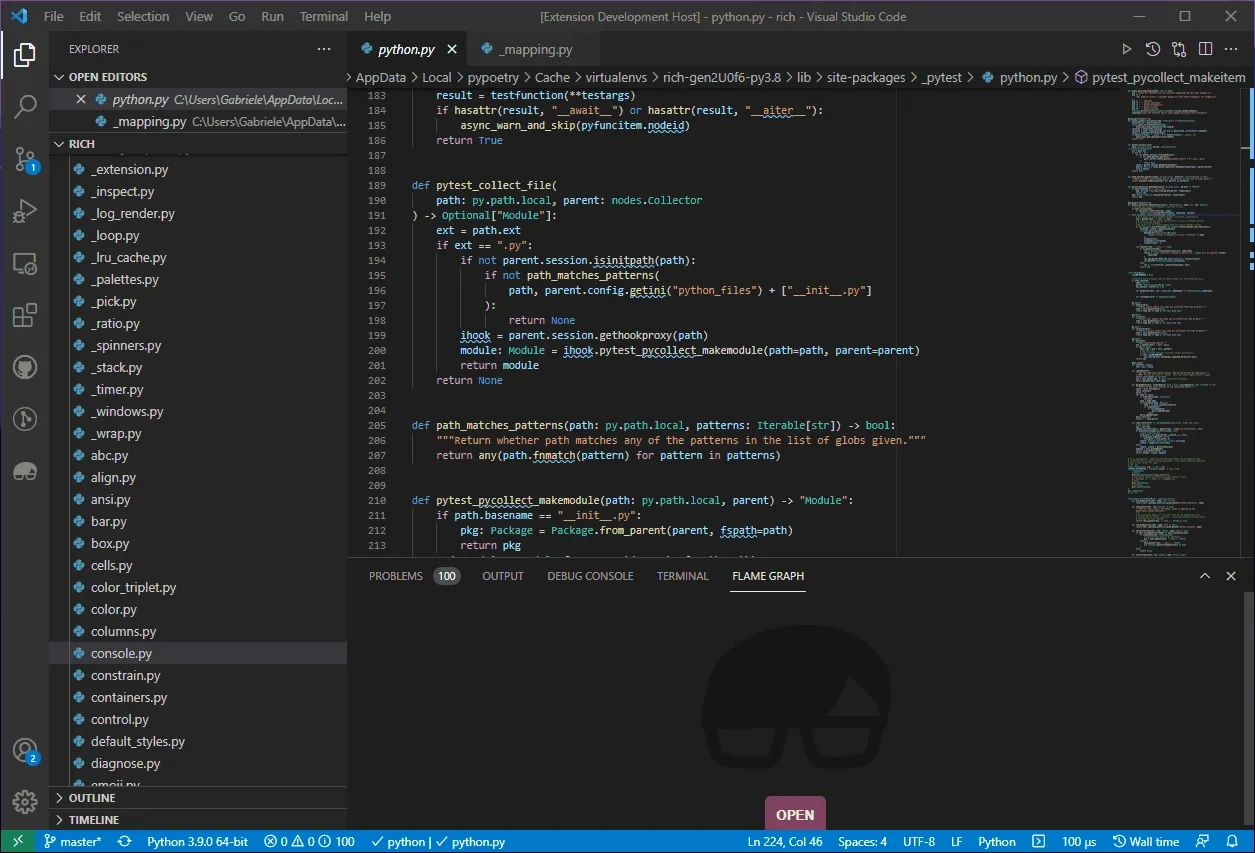
Austin TUI
The Austin TUI is a text-based user interface for Austin that gives you a top-like view of what is currently running inside a Python application. It is most useful for scripts that have long-running procedures as you can see where execution is at without tracing instructions in your code. You can also save the collected data from within the TUI and feed it to Flame Graph for visualisation, or convert it to the pprof format.
If you want to give it a go you can install it using pip with
pip install austin-tui --upgradeand run it with
austin-tui [OPTION...] command [ARG...]with the same command line as Austin. Please note that the austin binary should be available from within the PATH environment variable in order for the TUI to work.
The TUI is based on
python-curses. The version included with the standard Windows installations of Python is broken so it won’t work out of the box. A solution is to install the wheel of the port to Windows from this page. Wheel files can be installed directly withpip, as described in the linked page.
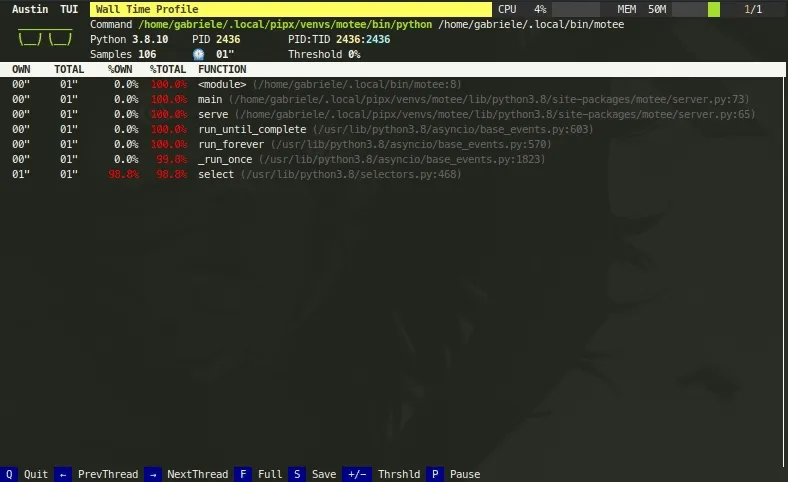
Austin Web
Austin Web is a web application that wraps around Austin. At its core, Austin Web is based on d3-flame-graph to display a live flame graph in the browser, that refreshes every 3 seconds with newly collected samples. Austin Web can also be used for remote profiling by setting the --host and --port options.
If you want to give it a go you can install it using pip with
pip install austin-web --upgradeand run it with
austin-web [OPTION...] command [ARG...]with the same command line as Austin. This starts a simple HTTP server that serves on localhost by default. When no explicit port is given, Austin Web will use an ephemeral one.
Please note that the austin binary should be available from within the PATH environment variable in order for Austin Web to work.
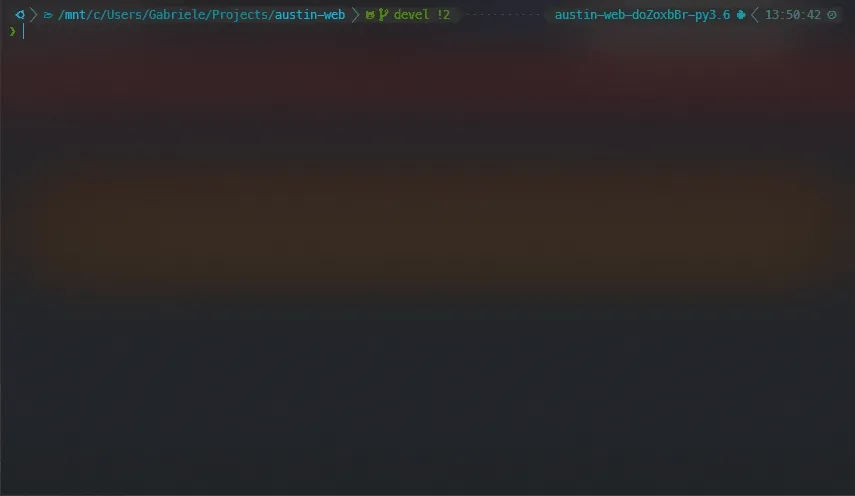
Speedscope
Austin output is now supported by Speedscope. However, the austin-python library comes with format conversion tools that allow converting the output from Austin to the Speedscope JSON format.
If you want to give it a go you can install it using pip with
pip install austin-python --upgradeand run it with
austin2speedscope [-h] [--indent INDENT] [-V] input outputwhere input is a file containing the output from Austin and output is the name of the JSON file to use to save the result of the conversion, ready to be used on Speedscope.
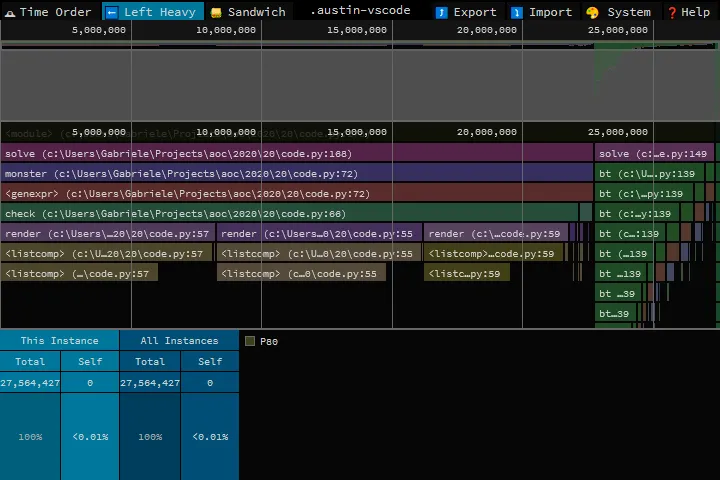
Google pprof
Austin’s format can also be converted to the Google pprof format using the austin2pprof utility that comes with austin-python. If you want to give it a go you can install it using pip with
pip install austin-python --upgradeand run it with
austin2pprof [-h] [-V] input outputwhere input is a file containing the output from Austin and output is the name of the protobuf file to use to save the result of the conversion, ready to be used with Google’s pprof tools.
← Back to projects